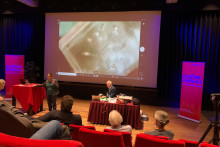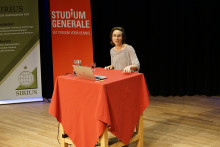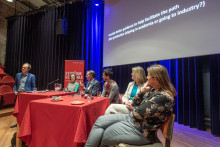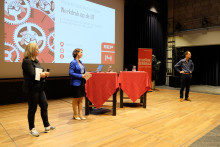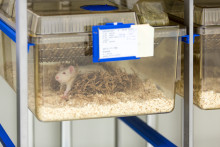‘The making of organs-on-a-chip may sound like science fiction, but it certainly is not’, assured Leferink at the start of her lecture. ‘For more than a decade, scientists all over the world have been working on it. And Twente is one of the biggest centers of the world in this field.’
Her background in tissue engineering during her master’s in biomedical engineering and her PhD was a door opener for this field of research. ‘Tissue engineering is one of the first steps in organ-on-a-chip technology. We need to learn to control cell behaviour without disturbing it. Advances in tissue engineering, semi-conductor fabrication and human cell sourcing facilitate the research.’
Like a library
What is an organ-on-a-chip really? ‘It mimics not the shape but the physiology on a small scale to study diseases: how these diseases develop, how they can be prevented, and how they respond to drugs’, explained Leferink.
She then described how to create an organ-on-a-chip. ‘We just need a sample. We dedifferentiate cells and reprogram them to induced pluripotent stem cell stage. Then we differentiate them to any cell we want. We organize the cells in a 3D model. Here it will mature to mimic the physiology’. The process is complex, but Leferink illustrates with a metaphor. ‘DNA is a library of books. Some books are present in the front and others are locked in an archive. Every cell has a different arrangement of these books.’
Coffee filter
Jan Jaap Wietsma provided the intermezzo, demonstrating how to produce an organ-on-a-chip model, a workshop he usually provides for high school students. He built a chip from plastic foil and an artificial membrane. ‘The membrane works like a coffee filter. Cells cannot pass, fluid does. You don’t even need expensive technology for that.’ The demonstration by Wietsma of how to create a simple chip taught the audience not only the procedure, but also a lesson of scientific work: ‘We will see whether it works, otherwise we try again. That is the fate of science.’
‘Away from animal testing’
Following the demonstration, Leferink talked about the potential and the future of organs-on-chips. ‘Before the development of organs-on-chips, it was all symptom-based diagnostics, non-translatable models, and non-specific treatment. See, my mother had to stop her breast cancer chemo to prevent a heart attack’, exemplified Leferink. Additionally, she claims: ‘We need to get away from animal testing. Right now, that is still not possible, because the Dutch law requires drugs to first be tested on different animals in order to be used on humans. But still 80 percent fail in the clinical trial.’
She presents reasons for these high numbers: ‘At the moment, efficacy testing of drugs happens on a cell line from mostly white men. This means they test just one cell type. It is not a complete test. Some drugs are not toxic for the heart, but can still be toxic for example for the liver. We need to find out how it affects the whole body.’
Human-on-a-chip
Leferink therefore introduced the concept of a ‘human-on-a-chip’. ‘It won’t be a chip that starts to move and says hello. It does not respond and has no consciousness. It is a chip that tests if treatments will work for you personally. There is a great importance of including the hormone system and limbic system to see how drugs affect the whole body and not its single parts.’
It's a future that is not yet within reach, says Leferink. ‘First of all, it’s a matter of cost-effectiveness. So we need to bring the chips’ use to a clinical level. We are not there yet, but we are close to developing combined organs-on-chips. So I believe that one day, we will have a human-on-a chip.’


